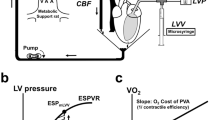Summary
Total global ischaemia of the normothermic working rat heart caused an initial positive inotropic response characterized by vigorous contractions. After ±15 s this response reached a peak whereafter the isotonic contraction amplitude started to decline. After ±3.5 min the heart ceased to beat. The low level of high energy phosphates (HEP), determined 3 min after the onset of ischaemia, indicated that these phases of contractility during ischaemia might play a significant role in depleting HEP. This was substantiated by the observation that inhibition of the contractions during ischaemia by low calcium or high potassium solutions resulted in conservation of myocardial adenosine triphosphate (ATP) and creatine phosphate (CP) stores. It also resulted in the prevention of contracture development during ischaemia and improved mechanical recovery during reperfusion. It was therefore concluded that inhibition of contractility immediatcly after the onset of total global ischaemia of the normothermic working rat heart is of prime importance in mechanical recovery during reperfusion.
Similar content being viewed by others
References
Humphrey SM, Thomson RW, Gavin JB (1981) The effect of an isovolumic left ventricle on the coronary vascular competence during reflow following global ischaemia in the rat heart. Circ Res 49:784–791
Bergel DH (1978) Mechanics of the arterial wall in health and disease. In: Bauer RD, Busse R (eds) The arterial system. Dynamics, control theory and regulation. Springer, New York, pp 3–14
Niesler RA, Fouche J, Peiser FE (1985) The measurement of heat production, mechanical power and oxygen consumption of the isolated working rat heart. Basic Res Cardiol 80:564–579
Neely JR, Liebermeister H, Battersby EJ et al (1967) Effect of pressure development on oxygen consumption by isolated rat heart. Am J Physiol 212:804–814
Gutman I, Wahlefeld A (1974) L-(+)-lactate. Determination with lactate dehydrogenase and NAD. In: Bergmeyer HU (ed) Methods of enzymatic analysis. 2nd ed. Academic Press Inc. New York London, p 146
Allen DG, Orchard CH (1984) Measurements of intracellular calcium concentrations in heart muscle: The effects of inotropic interventions and hypoxia. J Mol Cell Cardiol 16:117–118
Allen DG, Morris PG, Orchard CH (1983) A transient alkalosis precedes acidosis during hypoxia in ferret heart. J Physiol (London) 343:58–59
Krause S, Hess ML (1984) Characterization of cardiac sarcoplasmic reticulum dysfunction during short-term, normothermic, global ischaemia. Circ Res 55:176–184
Nakamaru Y, Schwartz A (1972) The influence of hydrogen ion concentration on calcium binding and release by skeletal muscle sarcoplasmic reticulum. J Gen Physiol 59:22–32
Matthews PM, Radda GK, Taylor GK (1981) A31P n.m.r. study of metabolism in the hypoxic perfused rat heart. Bioch Soc Trans 9:236–237
Hearse DJ, Stewart DA, Chain EB (1974) Recovery from cardiac bypass and electric arrest. Circ Res 35:448–457
Reibel DK, Rovetto MJ (1978) Myocardial ATP synthesis and mechanical function following oxygen deficiency. Am J Physiol 234:H620-H624
Neely JR, Grotyohahn LW (1984) Role of glycolytic products in damage to ischaemic myocardium. Dissociation of adenosine triphosphate levels and recovery of function of reperfused ischemic hearts. Circ Res 55:816–824
Piper HM, Schwartz P, Hutter JF, Spieckerman PG (1984) Energy metabolism and enzyme release of cultured adult rat heart muscle cells during anoxia. J Mol Cell Cardiol 16:995–1007
Zimmerman ANE, Hulsmann WG (1966) Paradoxical influence of calcium ions on the permeability of the cell membranes of the isolated rat heart. Nature (London) 211:646–647
Hearse DJ, Garlick PB, Humphrey SM (1977) Ischemic contracture of the myocardium: Mechanisms and prevention. Am J Cardiol 39:986–993
Author information
Authors and Affiliations
Rights and permissions
About this article
Cite this article
Steinmann, C.M.L., Lochner, A. & Niesler, R.A. Inhibition of contractility during the early phase of total ischaemia in the working heart. Recovery during reperfusion. Basic Res Cardiol 82, 297–303 (1987). https://doi.org/10.1007/BF01906862
Received:
Issue Date:
DOI: https://doi.org/10.1007/BF01906862




